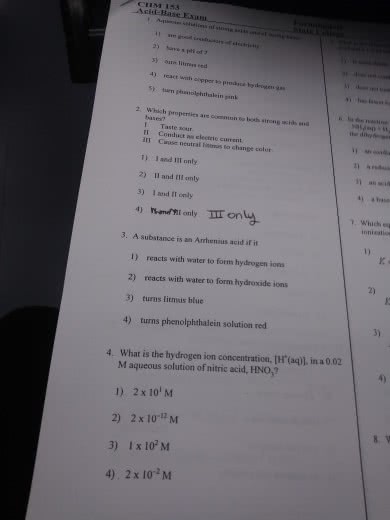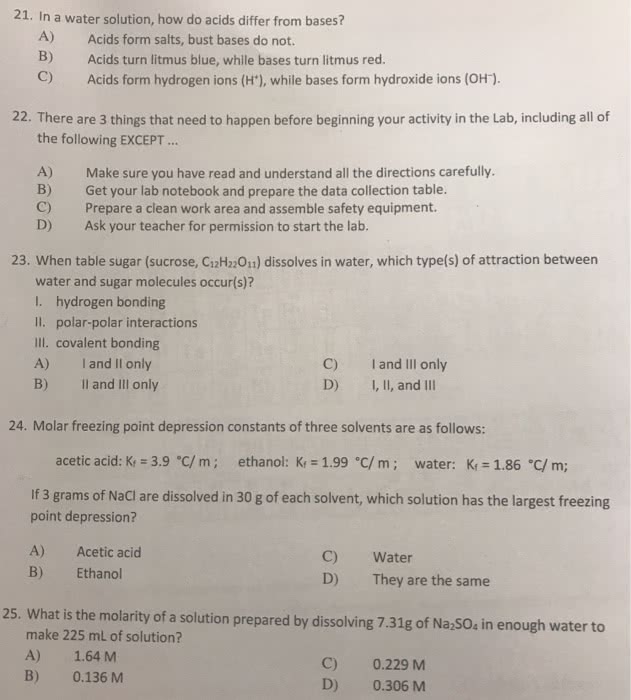L07 Chem 151 Lecture Notes - Lecture 5: Litmus, Polyatomic Ion, Conjugate Acid

28 September 2015
Lecture 5
I. Properties of Acids and Bases
A. Brønstead-Lowry Acid and Bases Diagram
Acids
Bases
General Properties
• Change litmus paper to red
• React with carbonates to form CO2
• React with active metals (that are
electropositive) to form H2 gas
• Change litmus paper to blue
• React with many metal ions to form
precipitates
Arrhenius Definition
A substance, that when dissolved in
H2O, increases the concentration of
hydrogen (hydronium) ions in the
solution
A substance, that when dissolved in H2O,
increases the concentration of hydroxide
ions (OH-) in solution
Neutralization
An Arrhenius acid reactions with an Arrhenius base to form a salt in which the cation
comes from the base and the anion comes from the acid
Brønstead-Lowry
Definition
An acid is a substance that can donate a
proton to another substance
A base is a substance that can accept a
proton from another substance
Lewis Definition
(broadest definition)
An acid is an electron pair acceptor
A base is an electron pair donor
Basic Formulas
• HnA: A-N is a simple anion (forming
binary acids, such as in HCl, H2S,
HCN, and HI) or a polyatomic anion
(forming oxoacids, such asH2SO4,
HNO3, HCLO)
• -COOH: organic acids (such as
CH3COOH and C6H5COOH)
• M(OH)m: Mm+ is a metal cation (such
as KOH and Ca(OH)2)
• R3N: Ammonia or an organic amine
where R can be H or an alkyl group (-
CH3, -CH2CH3, etc.)
Anhydrides
Nonmetal oxides are acid anhydrides:
• SO3 + H2O -> H2SO4
• CO2 + H2O -> H2CO3
• P2O5 + H2O -> H3PO4
Metal oxides are base anhydrides:
• Na2O + H2O -> 2NaOH
• Li2O + H2O -> 2LiOH
• CaO + H2O -> Ca(OH)2
Strong
Strong acids completely dissociate in
water and are strong electrolytes:
HCl, HBr, HI, HClO3, HClO4, H2SO4,
HNO3
Strong bases completely dissociate in water
and are strong electrolytes:
Any group one or two metal hydroxides are
strong bases
Weak
Weak acids only partially dissociate in
water and are weak electrolytes:
organic acids, oxoacids with fewer
oxygens, etc.
Weak bases only partially dissociate in
water:
Ie- NH4OH <---> NH4+ + OH-
find more resources at oneclass.com
find more resources at oneclass.com
Document Summary
Acids: change litmus paper to red, react with carbonates to form co2, react with active metals (that are electropositive) to form h2 gas. H2o, increases the concentration of hydrogen (hydronium) ions in the solution. Bases: change litmus paper to blue, react with many metal ions to form precipitates. A substance, that when dissolved in h2o, increases the concentration of hydroxide ions (oh-) in solution. An arrhenius acid reactions with an arrhenius base to form a salt in which the cation comes from the base and the anion comes from the acid. An acid is a substance that can donate a. A base is a substance that can accept a. An acid is an electron pair acceptor proton from another substance. A base is an electron pair donor (broadest definition) Basic formulas: hna: a-n is a simple anion (forming, m(oh)m: mm+ is a metal cation (such binary acids, such as in hcl, h2s,



